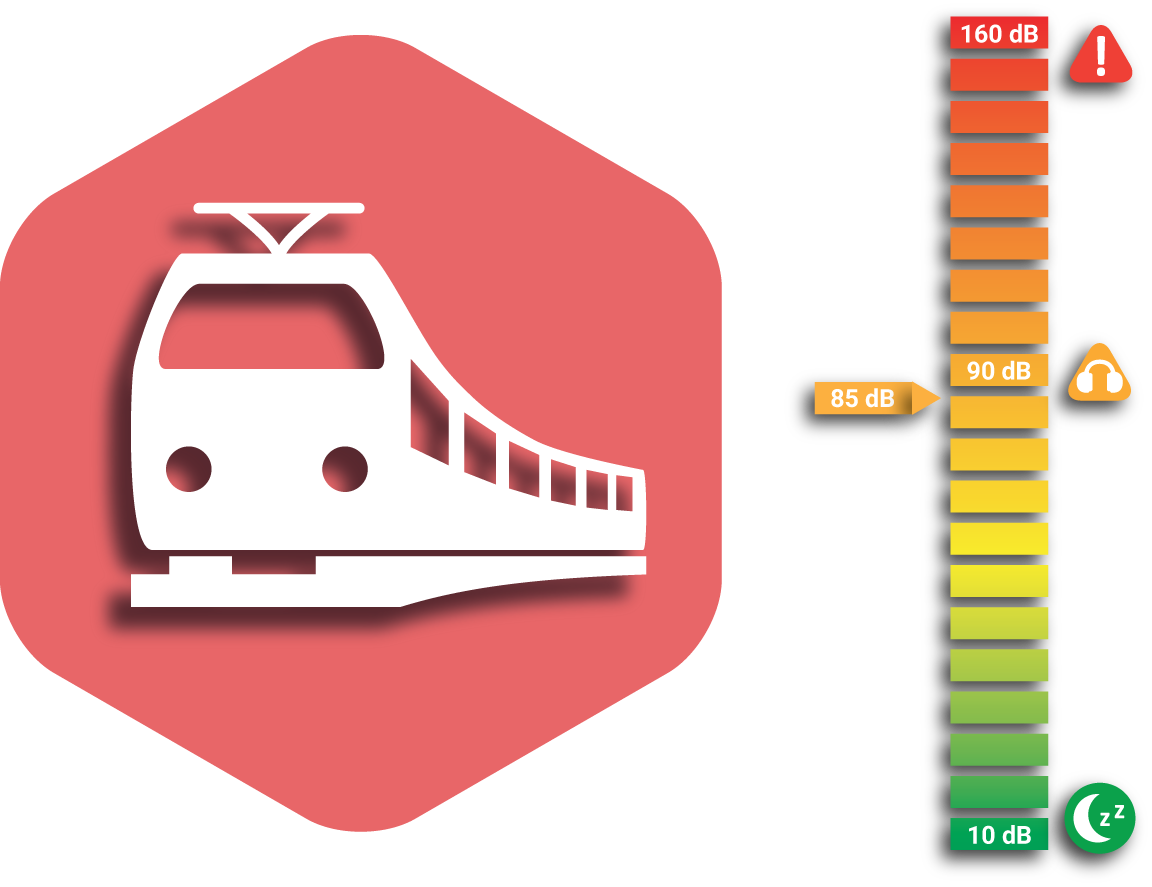Railway and Train Noise

Average SPL: 85 dB(A)
train engine type: electric,
speed: ?55 km/h,
distance from the observer: ?15m
Railway noise is comparable to the noise generated by airplanes and very different from the noise originated by road traffic and industrial machineries. This is mainly due to the fact that this kind of noise is not continuous but it is characterized by a series of single "events", which happen whenever a train passes by. These events may last differently in time and they are typically very loud if compared to other anthropic noise sources.
Railway noise is given by the sum of multiple components: locomotive engines, aerodynamic noise, coupling between wagon wheels and rails, coupling between pantograph and power line, acoustic signaling systems (e.g., horns, bells, whistles, sirens), braking systems and other auxiliary equipment (e.g., compressors, air conditioning systems, etc.).
The coupling between wagon/locomotive wheels and rails depends on the weight and the wheel size. It is directly proportional to the train speed, thus it becomes significant when the train accelerates (beyond 100 km/h).
The majority of trains (both passengers and freight) nowadays adopts electric traction engines working at 3kV. Their acoustic emission is significant at low speeds (below 60 km/h), thus in specific scenarios such as during the arrivals and the departures to/from railway stations.
The aerodynamic noise is given by the air flowing alongside the train and it becomes significant only at extremely high speeds (beyond 200 km/h).
Auxiliary thermal equipment give a small contribution, which is relevant at low speeds only (below 60 km/h).
Other specific acoustic events are represented by pure impulsive sounds, as the ones generated by braking events, usage of acoustic signaling systems (whistles, sirens, horns), presence of railroad junctions and switches.
From an acoustic modeling point of view, a train can be represented as a linear acoustic source, having a finite length, whose radiated sound energy is shaped as a semi-cylinder coaxial to the linear source. For points located near the railroad, the noise decreases of 3dB as a function of the square of the distance.
As a reference, we can consider the following average values, at 15m from the observer:
Railway noise is given by the sum of multiple components: locomotive engines, aerodynamic noise, coupling between wagon wheels and rails, coupling between pantograph and power line, acoustic signaling systems (e.g., horns, bells, whistles, sirens), braking systems and other auxiliary equipment (e.g., compressors, air conditioning systems, etc.).
The coupling between wagon/locomotive wheels and rails depends on the weight and the wheel size. It is directly proportional to the train speed, thus it becomes significant when the train accelerates (beyond 100 km/h).
The majority of trains (both passengers and freight) nowadays adopts electric traction engines working at 3kV. Their acoustic emission is significant at low speeds (below 60 km/h), thus in specific scenarios such as during the arrivals and the departures to/from railway stations.
The aerodynamic noise is given by the air flowing alongside the train and it becomes significant only at extremely high speeds (beyond 200 km/h).
Auxiliary thermal equipment give a small contribution, which is relevant at low speeds only (below 60 km/h).
Other specific acoustic events are represented by pure impulsive sounds, as the ones generated by braking events, usage of acoustic signaling systems (whistles, sirens, horns), presence of railroad junctions and switches.
From an acoustic modeling point of view, a train can be represented as a linear acoustic source, having a finite length, whose radiated sound energy is shaped as a semi-cylinder coaxial to the linear source. For points located near the railroad, the noise decreases of 3dB as a function of the square of the distance.
As a reference, we can consider the following average values, at 15m from the observer:
| Noise component | Train @ 20 km/h | Train @ 50 km/h | Train @ 100 km/h | Train @ 200 km/h |
| Electric engine | 82 dB | 84 dB | 86 dB | 88 dB |
| Coupling wheels-rails | 75 dB | 88 dB | 95 dB | 105 dB |
| Aerodynamic | < 70 dB | < 70 dB | 80 dB | 95 dB |
| Overall (average) | 80 dB | 85 dB | 95 dB | 105 dB |